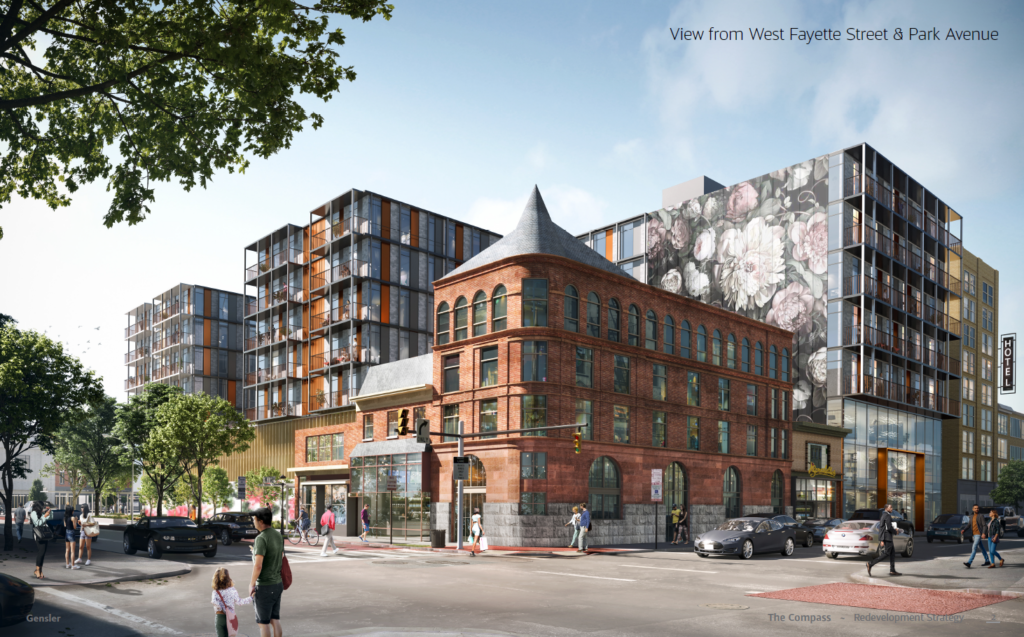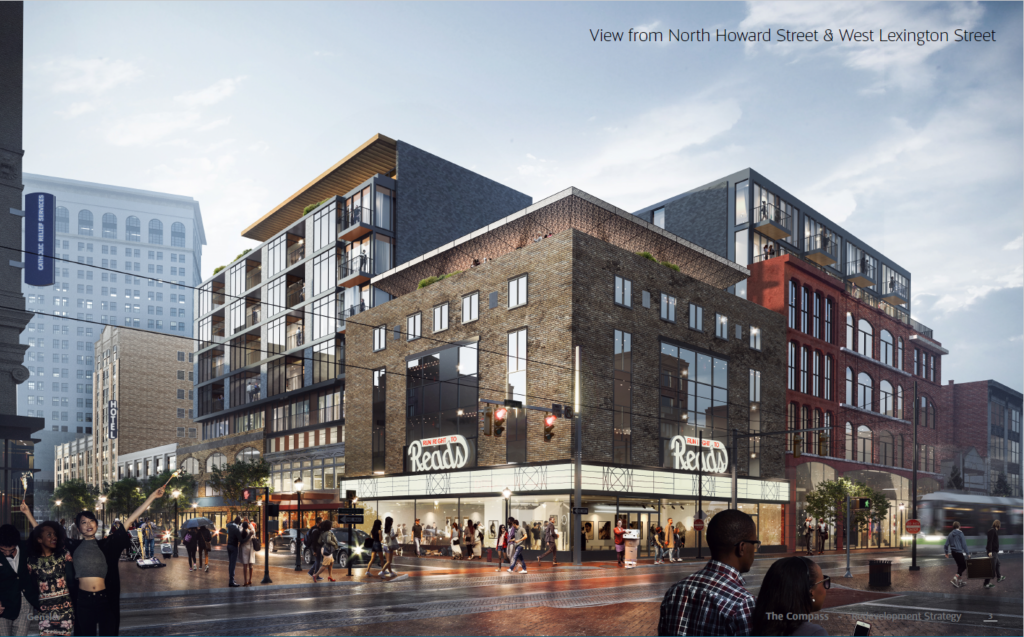Although they have been vacant for decades, located in a blighted neighborhood and repeatedly dismissed as an impossible development project, a cluster of buildings near Howard and Lexington constitutes “a once in a lifetime opportunity to help advance the revitalization of the west side.” That’s the view of Jayson Williams, CEO of Mayson Dixon Companies and one of the developers behind the proposed Compass project.
 Westside Partners – a joint venture of Mayson Dixon, Vitruvius and Partnered – is currently designing a $100 million, mixed-use redevelopment of 18 properties bordering West Lexington, North Howard, Fayette, Marion and Park (parts of the former Super Block). The project has been a long time coming. The Baltimore Development Corporation (BDC) selected Westside Partners for the redevelopment in March 2019 and construction is not expected to begin before the end of 2022. But Williams believes that conditions are finally aligning to support not only The Compass but a broad revitalization of the west side.
Westside Partners – a joint venture of Mayson Dixon, Vitruvius and Partnered – is currently designing a $100 million, mixed-use redevelopment of 18 properties bordering West Lexington, North Howard, Fayette, Marion and Park (parts of the former Super Block). The project has been a long time coming. The Baltimore Development Corporation (BDC) selected Westside Partners for the redevelopment in March 2019 and construction is not expected to begin before the end of 2022. But Williams believes that conditions are finally aligning to support not only The Compass but a broad revitalization of the west side.
“If you look at where The Compass is located, it sits right in a donut hole of amazing development,” he said. “There is half a billion dollars of development happening in the Bromo Arts District,” including the $40 million redevelopment of Lexington Market, the proposed $150 million redevelopment of Royal Farms Arena, the Howard Row project and other redevelopment along Park Avenue.

Jayson Williams, CEO of Mayson Dixon Companies
Williams hopes the recent passage of the federal infrastructure bill could further benefit the region. The Compass, he noted, “is a transit-oriented development. With the infrastructure bill, I am hopeful there will be upgrades to the light rail line which has a stop right in front of The Compass.”
“If we could get all three projects going – Lexington Market, Royal Farms Arena and The Compass – you would have a new center of gravity in the traditional downtown business district on the west side,” said Colin Tarbert, CEO of the Baltimore Development Corporation. “That area used to be the commercial, five-and-dime, department store hub of the city. We could create that vibrancy again.”
A redeveloped west side would, of course, offer different, updated facilities and amenities.
“Downtown needs a lot of different things right now. We need more restaurants and food options, more health and fitness facilities. People want to live near where they work, so we need more residential downtown but not just high-priced, luxury residences,” Williams said. “To deliver all of that, we need to create very thoughtful partnerships with the community around us and city and state officials to ensure that we can keep costs reasonable for people who want to relocate and be downtown again.”
 Williams is working to create opportunities for small, local and minority-owned businesses to locate and thrive on the west side. Williams’ great grandfather operated a three-seat shoeshine and repair stand in Lexington Market for years, became a highly respected member of the local business community and secured jobs at Lexington Market for many family and community members – some of whom went on to start their own businesses. The Compass property, Williams noted, includes the former Read’s Drug Store – the site of the country’s first anti-segregation sit-in.
Williams is working to create opportunities for small, local and minority-owned businesses to locate and thrive on the west side. Williams’ great grandfather operated a three-seat shoeshine and repair stand in Lexington Market for years, became a highly respected member of the local business community and secured jobs at Lexington Market for many family and community members – some of whom went on to start their own businesses. The Compass property, Williams noted, includes the former Read’s Drug Store – the site of the country’s first anti-segregation sit-in.
“My grandfather was actually turned away from Read’s,” Williams said. “His grandson now owns a piece of that history and is reclaiming investment that African Americans have not had at a high level here in Baltimore… I need to own the legacy of my great grandfather and how he helped others and stood up for the community. We can bring back these incredible, historic commercial spaces and create opportunities for African American owned businesses.”